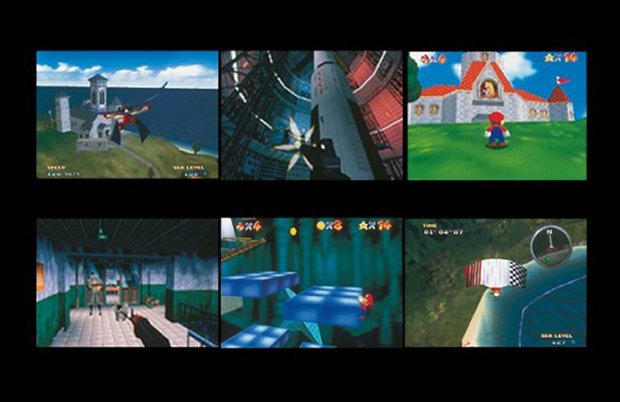ClassicRadar: The best history of E3 on the internet
As long as you're only interested in the shows that took place between 1995 and 2006
For over a decade the annual Electronic Entertainment Expo (aka E3) has been the highlight of the gaming calendar. But - with many of the big players deserting the show - the doors have closed on this incredible circus of sensory stimulation. E3 as we know it might be "evolving" but it's not going to be the same mind-blowing spectacle.
To celebrate the relatively short - but always raucously enjoyable - lifespan of the show, we look back and remember why, for one week every year, gaming was directly in the spotlight of the world's media and E3 was one of the most exciting places to be on the entire planet.
Read on and discover all the good stuff from each of E3's 12 shows...
1995: It all begins
Almost 40,000 people attended the very first E3 at the LA Convention Center. The show's big news came from Sega, which announced the surprise early launch of its Saturn console - it made its way into some shops during the show. Sega boasted that it would have dozens of games ready for the system by Christmas.
This news was all the more juicy thanks to Nintendo revealing that it was delaying the release of its Ultra 64 (later to become Nintendo 64) until April '96, effectively giving its rival almost a year head start. Nintendo big cheese Howard Lincoln told GamesMaster magazine that the reason for the delay was "Nintendo's never-ending quest for better games".
To cushion the blow, Nintendo unveiled a strong line-up of SNES titles, which included Doom, Killer Instinct and Donkey Kong Country 2. It also stated that the European launch of Ultra 64 would be almost simultaneous with the US debut. As it turned out, the console eventually launched in the US in September '96 and didn't show up in Europe until six months later. Oh well, better luck this time.

Above: The graphics from Virtual Boy's Galactic Pinball. Interested in searing red semi-3D pinball? No? Nobody was then, either
Weekly digests, tales from the communities you love, and more
The house of Mario was also busy pushing its ill-fated Virtual Boy system, calling it a "unique gameplay experience" (sounds familiar) and committing to spending $25 million to promote it. Nintendo claimed that over 100 third-party developers were working on games for it. Atari (the old one, that is) was also getting into the exciting world of futuristic virtual realities by showing off its own VR headset for the Jaguar console.
With the launch of PlayStation just months away, Sony turned up to the show with a confident swagger ready to get people pumped about its little grey box. It announced that the console would launch for the Saturn-busting price of $299 ($100 less than its Sega rival) and that by Christmas there would be 50 titles available for the machine.
To show off its new console, Sony rolled out games such as Ridge Racer, Tekken, Wipeout and Warhawk. Attendees weren't unanimously convinced, however, that Sony would be able to cut the mustard against Sega and Nintendo. PlayStation's world domination followed soon after.
One strangely familiar game at the show was Ratchet & Bolt for Sega Genesis 32X, which boasted "the biggest videogame boss in known history" (apparently it was over 30 screens tall) and featured over 33 weapons. The game was eventually canned, which is a shame because it sounded pretty good...
1996: Nintendo dominates with N64
After further delays, Nintendo's SNES successor still hadn't been released and E3's hordes were hungry to sample what N64 would have to offer. Hour-long queues had to be endured by anyone who wanted to try out the system formerly known as Ultra 64. Despite many show-goers struggling with the radical analog controller, games like Super Mario 64, GoldenEye and Pilotwings 64 ensured that N64 was a genuine show-stopper.
Nintendo also revealed Game Boy Pocket, which was the first significant redesign of its all-powerful Game Boy since the handheld was released seven years earlier. And, in an effort to boost interest in its struggling Virtual Boy, Nintendo slashed the price of the console to $100. But even Nintendo couldn't save the doomed monochromatic curiosity and production ceased later in the year.
After the release of PlayStation, Sony was fast emerging as a real force to be reckoned with and it played a strong hand at the show by cutting the price of its console to $200. Sega followed its competitor's lead and announced that gamers would be able to pick up a Saturn for the same amount, which was effectively half price compared to when the console launched the previous year.

Above: Mario 64, GoldenEye and Pilotwings 64 were some of the first playable N64 games
Despite a good line-up of titles (including Virtua Fighter 2, Virtua Cop 2 and the still-held-in-high-regard NiGHTS), and the unveiling of its NetLink modem which would allow gamers to play Saturn online (for $200), the general murmur around the convention centre was that Sega was beginning to wobble.
So, with Sega faltering and Nintendo's new console not even at the starting line, life in Sony-land was already looking rosy. New Ridge Racer, Tekken and Wipeout games were gratefully received, while totally fresh titles Soul Blade and Crash Bandicoot were grabbing considerable attention. After a brief appearance by the really-not-very-good Polygon Man at the previous E3, Sony also adopted Crash as its official PlayStation mascot.



